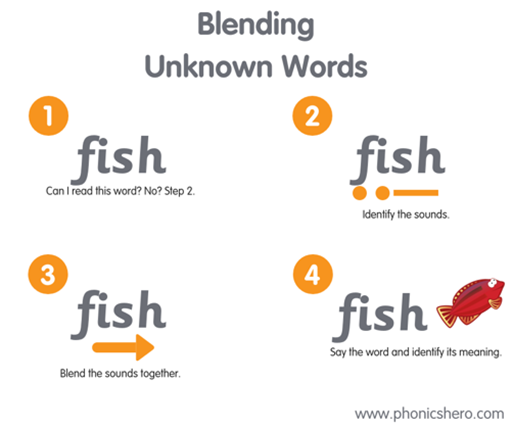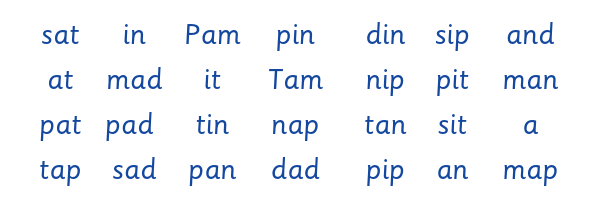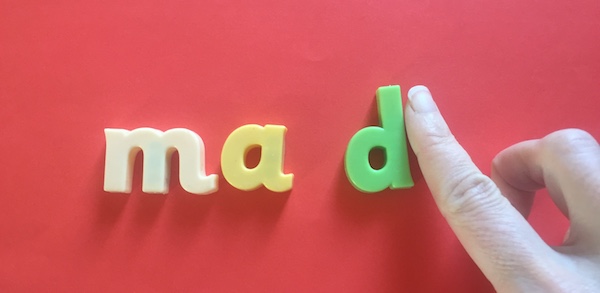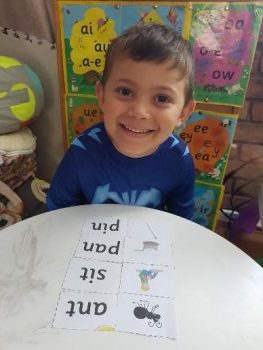
I’ve pushed the learning of letter sounds all year, but the penny is not dropping on blending.”
Blending has been a challenge and the kids are getting frustrated with it. We’ve decided to go back to the letter sounds.”
When I hear things like this my answer is always “Blend! Blend! Blend!”
I say this because I don’t believe we do enough of it. Is it because we feel it is too difficult for young children to achieve? Or is it just easier for us to allow children to simply over-learn the letter-sound correspondences in isolation?
Either way, it can’t be overlooked; blending is a crucial skill that every child needs to start reading unknown words. It’s crucial that in England (and in an increasing number of Australian states), the Year One Phonics Check includes nonsense words to assess whether a child can blend sounds—or perhaps more accurately, to check whether the teacher has effectively taught blending.
Blending is the skill that helps us read, especially when confronted with unfamiliar words. For young children, most words are unfamiliar and they will need to blend many of the words they encounter. It involves pushing together the sounds of the letters in the word in order to create the whole word. For example, a child trying to read the word ‘fish’, will isolate each of the letter sounds. When these three sounds are said in sequence, the word ‘fish’ is spoken.
 How a child should tackle unknown words for reading.
How a child should tackle unknown words for reading.Blending is not a difficult skill to master. It simply requires PRACTICE and lots of it. Phonics Hero’s games provide over 39 hours of practice! You can sign up for a free parent 7-day trial or as an educator. It’s critical to introduce children to the phonemic awareness skills of oral blending at an early age. Modelling how to orally blend to create a spoken word and how to break a word apart is how to start a child’s blending and segmenting journey. Once children can blend at an oral level, the blending of words in print becomes a lot easier. There is a great blog post on oral blending and segmenting.
Below is a child who began his reading journey at 3.5 years of age. While it is not fluent, it is a start. Keep watching the footage as we see the same child 6 months later.

The key is to ALWAYS incorporate blending activities when teaching letter sounds. Do not wait until all the sounds of the alphabet are done. After a handful of sounds have been learned, words can be blended. Take the following group of letter sounds:

After only these 8 letter sounds are taught, we can begin teaching children to blend words such as sat, pan, tap, mad.
 28 opportunities for practise with only 8 sounds!
28 opportunities for practise with only 8 sounds!Before I go into our classroom tips, if you are looking for simple, home-based blending tips for parents – check out our how-to guide for parents with fun, practical activities to teach your child to blend at home.
Having to provide students with a bank of decodable words and sentences, which are also differentiated, mid-lesson can leave you flustered. Phonics Hero’s click-and-go Phonics Lessons are designed to ease the workload of planning a great phonics lesson. It contains over 3,700 decodable words and over 2,400 sentences – all with sound buttons, blending support and pictures to check understanding. Check out this whistle-stop tour of a blending lesson:
You can start a 30-day trial of the no-prep Phonics Lessons with a Teacher Account.
1. Immerse the children in oral blending as early as you can. Watch this 4 year old practising this critical skill:

This can be done through games such as:
2. Grab some magnetic letters and physically show the letters crashing into each other as you blend the word. This visual representation of blending can often be that ‘lightbulb moment’ for a child where blending starts to make sense.
 Physically show blending with the magnetic letters being pushed together.
Physically show blending with the magnetic letters being pushed together.3. Always have pictures ready for the words the children are blending. These pictures are not there to encourage guessing but as a confirmation after blending. This will help them blend easily because they can see the spoken word that has been formed through the pictures. Eventually, blending becomes automatic and pictures will not be needed. Our reading worksheets are a great tool to help you practise with pictures (teachers access them or parents can purchase them).
 A child matching the words and the pictures.
A child matching the words and the pictures.4. If children are not saying the correct word when blending isolated sounds, try these other blending techniques:



In this short video I demonstrate these three blending techniques:

5. Blend! Blend! Persevere! Blend! Blend! These skills of blending and segmenting do not develop automatically. They must be modelled and explicitly taught. Don’t give up and your students will reap the rewards of your perseverance.
It can feel like a real challenge for a Year Three teacher who has students who can’t blend ‘cat’ and also those who are reading chapter books! For these older students, it’s often the same issues the beginning reader is having.
In this instance, firstly, don’t soldier on with learning more complicated sounds (two-letter digraphs or three-letter trigraphs), you will be overloading a child’s working memory. Go back and start with the basic single letter sounds.
Next, check their phonological and phonemic awareness skills. These are the underlying skills that a child needs to make the ‘blending penny drop’. Read this blog post on assessment.
Go back to the basics. You might need to stop blending with letters and go back to oral blending. It may feel like you are going backwards if the child is much older but this skill needs to be firmly embedded. Ask yourself, are you teaching where they are at, or where they should be?
For 99% of children the blending penny will drop – it just needs lots of modelling, repetition, practice and a steadfast determination that every child will learn to read!
Thank-you for your practical tips on teaching early readers to blend. I am a reading intervention teacher working with students from Kindergarten to Year 2. I have put several of your strategies into practise with some successes where there has not been previously.
We’re so glad you found this blog helpful, Fiona! If you’re not on our mailing list, feel free to sign up – you’ll receive email updates whenever a new blog is published.
Hi
I have a child who can orally blend sounds together well and can instantly recall the phoneme for any given grapheme but they struggle to blend independently when reading. I was wondering if you have any suggestions as to what I could do?
Hi Laura,
When it comes to blending, the key is really just practice, practice and more practice! You might want to have a look at our other post How to Teach a Child to Read With Phonics as well. Our CEO Katherine also found that when she tried to move her little one on to blending with graphemes, it was a little too early and she had to go back to practice orally blending for a while longer.
Hope this helps,
Jenny
Hi Jenny,
Thank you for your help. We continued to practice lots and the children are getting there. Thank you for your help.
Laura
This is a great article! I have been teaching blending for a few years now and it can be a bit tough. This article is a great reminder of the basics.
We’re so glad you enjoyed it! If you haven’t already, be sure to check out our other blog posts, which are chock-full of phonics teaching tips and tricks!